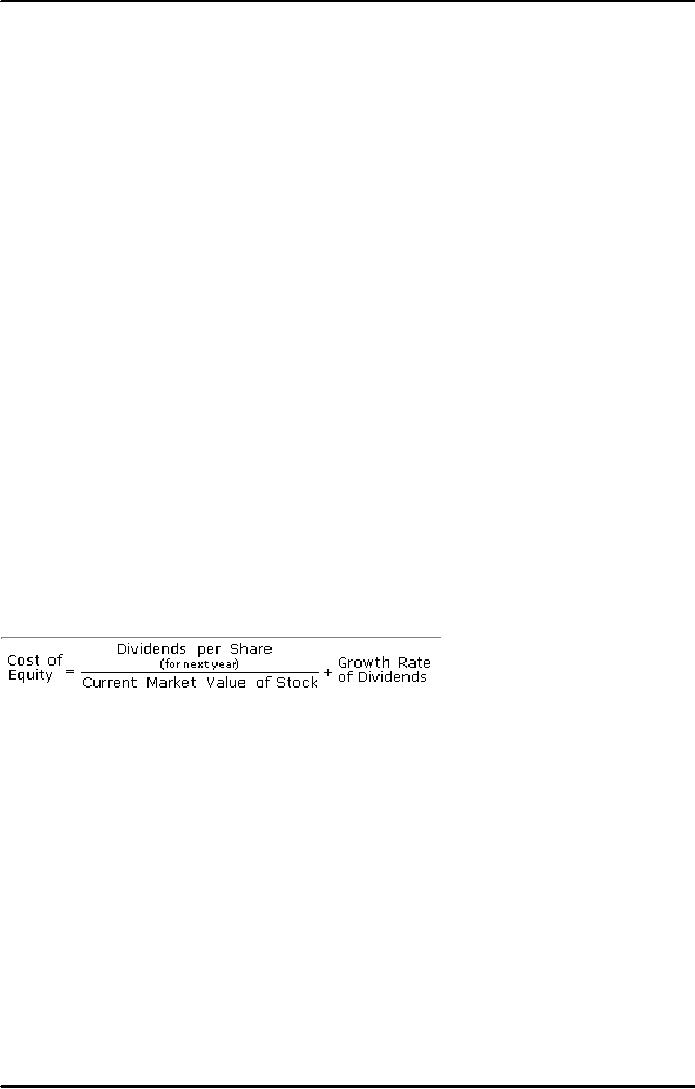 |

Corporate
Finance FIN 622
VU
Lesson
18
COST
OF CAPITAL & CAPITAL
STRUCTURE
The
following topics will be
discussed in this lecture.
Cost
of Capital & Capital Structure
Components
of Capital
Cost
of Equity
Estimating g or
growth rate
Dividend
growth model
Cost
of Debt / Bonds
Cost
of Preferred Stocks
COST
OF CAPITAL
The
required return is necessary to make a
capital budgeting project such as
building a new
factory
worthwhile.
Cost of capital would include the
cost of debt and the cost of
equity.
The
cost of capital determines
how a company can raise
money (through a stock
issue, borrowing, or a
mix
of the
two). This is the rate of return
that a firm would receive if
it invested its money
someplace else with
similar
risk.
CAPITAL
STRUCTURE
Capital
structure of a typical company may
consist of ordinary shares,
preference stock, short term and
long
term loan,
bonds and leases. These
components in capital structure
have their own cost
and if we add all
the
individual components cost after
adjusting with the weight age of
each, the resultant value is
known as
weighted
cost of capital. As you have
already covered in your
earlier lessons that
normally we use WACC
as
discount
rate to find the present
value of future cash flows
emerging from a project, so it is of
immense
importance to
calculate the correct WACC. And
you are also aware
that if the WACC is incorrect it
may
lead
to serious consequences.
In
order to compute the WACC we
need to calculate the individual
components cost. First of all we
take up
the
Equity part of the capital
and will see how we can
compute the cost of equity.
COST
OF EQUITY
In financial
theory, the return that stockholders
require for a company is called
cost of equity. The
traditional
formula is the dividend capitalization
model:
A firm's
cost of equity represents the
compensation that the market
demands in exchange for
owning the
asset
and bearing the risk of ownership.
Let's
look at a very simple example:
let's say you require a rate
of return of 10% on an investment in
stock
A. The
stock is currently trading at $10
and will pay a dividend of
$0.30. Through a combination
of
dividends
and share appreciation you require a
$1.00 return on your $10.00
investment. Therefore the stock
will
have to appreciate by $0.70, which,
combined with the $0.30 from dividends,
gives you your 10%
cost
of
equity.
We
shall discuss two methods we
can use to determine the
cost of equity.
First,
we'll take up dividend
growth models and then
security market line
approach to calculate the cost
of
equity.
Assuming
that dividends will grow at a constant
rate in future (growth rate
=g), price per share Po
(current
price)
can be found by the following
formula:
Po = Do x (1 + g) /
Re g
Or
Po = D1 / Re
g
Where
D1 is the dividend after period 1 and Re
represents return on equity.
We can
re-arrange this equation in order to
calculate the Re as under:
59

Corporate
Finance FIN 622
VU
Re = D1 / Po +
g
This
equation tells us that we need
three variables to work out
the cost of equity. These are current
price
Po,
dividend in period 0, and Do
and growth rate.
Most
complex variable in the above equation is to determine
the "g" variable. You can
obtain the Po and
Do very
easily from internal or external
sources. We can use some
statistical techniques to forecast g
using
the historical
data. More precisely using
trend and regression
analysis we can obtain the
value of g.
The
primary advantage of dividend growth
model is that it is very simple to
understand and use.
However,
there
are some problems also
associated with this
approach.
It is
only applicable to the firms which
pay dividend regularly if not
constantly. Therefore, a firm with
no
dividend
history will find it
useless.
The
other problem is an unrealistic
assumption of constant growth of
dividends. We may not find
any such
company
which has a history of
constant growth in dividends. These
two limitations make this model to
be
used
in selected scenarios, for
example, where the company
may have distributed the dividends
consistently
in the
past.
The
other problem is that the
estimated cost of equity is very
sensitive to the estimated growth
rate.
Finally,
this approach does not take
into account the risk level. There is no direct
adjustment for the risky-
ness
of the investment. For instance, there is
no adjustment for the degree of certainty
or uncertainty in
estimated
growth rate for
dividends
The
other way to compute the
cost of equity is SML
(security market line) which
tells us that the required
rate
of return on a risky investment depends on
three things.
i)
The
risk free rate, Rf
ii)
Market
risk premium, (Erm Rf)
iii)
Systematic
risk of the asset known as beta,
B
Using
SML we can write the equation as
under:
Ere = Rf + Be x
(Erm Rf)
Where
Ere = is
expected return on equity.
Be = is
Beta of equity.
This
method is also suffering from advantages
and disadvantages. First it
explicitly adjusts the risk
and
second,
it is applicable to companies other
than just those with
steady dividend growth. Thus
it may be
useful
in wider circumstances.
The
SML approach heavily relies on
two things the market risk premium
and beta coefficient. And if
our
estimates
are not very accurate then
the cost of equity number will be incorrect
and misleading as well.
The
demerit of both dividend model and
SML is that both consider
past data to predict the
future.
Economic
conditions and indicator in
future are not the same as
were in past. However, both
methods do
provide
us relative guidance in computing the
cost of equity.
Before we move
ahead to cost of debt, let's
take a look how we can
raise capital in the long
run. From a
firm's
perspective, followings are the
ways to build the
capital:
venture
capital
issuing
share to public
IPOS
subsequent
issue of share right
issue
private
placement of shares
60

Corporate
Finance FIN 622
VU
bank
loans
debt
instruments
leases
There
are some rules and
regulations for raising
capital for each of the
above categories. We shall
discuss
here
some of the issues relating to Equity
capital issuing shares
through IPOs and subsequent
issue of
shares
like right issue.
� company
must be listed on stock
exchange
� must
be registered with security &
exchange commission of Pakistan
SECP
� company
issues prospectus
� underwriting
the share issue
Underwriter
refers to a firm that acts
as intermediary between a company issuing
shares and
the
public.
underwriter
normally perform following
services
� devising
method for issuing
shares
� setting
the price of new
shares
� marketing /
selling of securities
Underwriters
may buy securities for
less than the price set by
the company and then
selling
them to
public. if any amount of shares
not subscribed by the public
then underwriter
takes
up the
under-subscribed shares.
Often
underwriter forms a group to share the
risk, known as
syndicate.
COST
OF DEBT:
Debt
component of capital may include several
line items like preferred
stocks, loans from various
financial
institutions
with varying terms and cost.
Some of the loans may be having
fixed or floating interest
rate. The
other
items in the debt are bonds
and leases.
The
effective rate that a company
pays on its current debt can
be measured in either before- or after-tax
returns;
however, because interest expense is
deductible, the after-tax cost is seen
most often. This is
one
part
of the company's capital structure,
which also includes the cost
of equity.
A
company will use various
bonds, loans and other forms
of debt, so this measure is useful for
giving an
idea
as to the overall rate being paid by the
company to use debt financing. The
measure can also give
investors
an idea as to the risky-ness of the
company compared to others,
because riskier companies
generally
have a higher cost of debt.
To get
the after-tax rate, you simply
multiply the before-tax rate by one
minus the marginal tax rate
(before-
tax
rate x (1-marginal tax)). If a
company's only debt were a
single bond in which it paid 5%, the
before-tax
cost
of debt would simply be 5%.
If, however, the company's marginal tax
rate were 40%, the
company's
after-tax
cost of debt would be only
3% (5% x (1-40%)).
Like
loans, bonds may have
several issues of varying terms,
carrying different interest
cost with wide gap
between
their cost and market
value. Leases may have the
same characteristics like
loans and debts.
To
find the cost of debt, we need to
calculate the cost of each
class of debt and then
finding the weighted
average
of the cost of debt. For example, if
there are five bond
issues outstanding at any time, we
will
calculate
the cost of each issue and
then move to weighted average of
cost of bond by using their
individual
weight in
total bond capital.
COST
OF PREFERRED STOCK:
To
start computing the cost of debt, we
take up the first item in debt
family preferred stock, which
is
fairly
straightforward calculation.
As we
know that preferred stocks
carry fixed dividend every
period. There's no variation in
dividend level.
This
means that dividend from
preferred stock is essentially
perpetuity.
� cost
of preferred stock can be calculated
from the following
� R = D/
Po
61

Corporate
Finance FIN 622
VU
�
for
example if the dividend is R 3.50/-
per share and current market
price is rs.40/-, then the
Rp
will
be:
� Rp =
3.50 / 40 = 8.75%
We
shall take up the two main
issues for calculating cost
of debt for loans and
leases in other hand outs
to
be delivered in
future.
62
Table of Contents:
- INTRODUCTION TO SUBJECT
- COMPARISON OF FINANCIAL STATEMENTS
- TIME VALUE OF MONEY
- Discounted Cash Flow, Effective Annual Interest Bond Valuation - introduction
- Features of Bond, Coupon Interest, Face value, Coupon rate, Duration or maturity date
- TERM STRUCTURE OF INTEREST RATES
- COMMON STOCK VALUATION
- Capital Budgeting Definition and Process
- METHODS OF PROJECT EVALUATIONS, Net present value, Weighted Average Cost of Capital
- METHODS OF PROJECT EVALUATIONS 2
- METHODS OF PROJECT EVALUATIONS 3
- ADVANCE EVALUATION METHODS: Sensitivity analysis, Profitability analysis, Break even accounting, Break even - economic
- Economic Break Even, Operating Leverage, Capital Rationing, Hard & Soft Rationing, Single & Multi Period Rationing
- Single period, Multi-period capital rationing, Linear programming
- Risk and Uncertainty, Measuring risk, Variability of return–Historical Return, Variance of return, Standard Deviation
- Portfolio and Diversification, Portfolio and Variance, Risk–Systematic & Unsystematic, Beta – Measure of systematic risk, Aggressive & defensive stocks
- Security Market Line, Capital Asset Pricing Model – CAPM Calculating Over, Under valued stocks
- Cost of Capital & Capital Structure, Components of Capital, Cost of Equity, Estimating g or growth rate, Dividend growth model, Cost of Debt, Bonds, Cost of Preferred Stocks
- Venture Capital, Cost of Debt & Bond, Weighted average cost of debt, Tax and cost of debt, Cost of Loans & Leases, Overall cost of capital – WACC, WACC & Capital Budgeting
- When to use WACC, Pure Play, Capital Structure and Financial Leverage
- Home made leverage, Modigliani & Miller Model, How WACC remains constant, Business & Financial Risk, M & M model with taxes
- Problems associated with high gearing, Bankruptcy costs, Optimal capital structure, Dividend policy
- Dividend and value of firm, Dividend relevance, Residual dividend policy, Financial planning process and control
- Budgeting process, Purpose, functions of budgets, Cash budgets–Preparation & interpretation
- Cash flow statement Direct method Indirect method, Working capital management, Cash and operating cycle
- Working capital management, Risk, Profitability and Liquidity - Working capital policies, Conservative, Aggressive, Moderate
- Classification of working capital, Current Assets Financing – Hedging approach, Short term Vs long term financing
- Overtrading – Indications & remedies, Cash management, Motives for Cash holding, Cash flow problems and remedies, Investing surplus cash
- Miller-Orr Model of cash management, Inventory management, Inventory costs, Economic order quantity, Reorder level, Discounts and EOQ
- Inventory cost – Stock out cost, Economic Order Point, Just in time (JIT), Debtors Management, Credit Control Policy
- Cash discounts, Cost of discount, Shortening average collection period, Credit instrument, Analyzing credit policy, Revenue effect, Cost effect, Cost of debt o Probability of default
- Effects of discounts–Not effecting volume, Extension of credit, Factoring, Management of creditors, Mergers & Acquisitions
- Synergies, Types of mergers, Why mergers fail, Merger process, Acquisition consideration
- Acquisition Consideration, Valuation of shares
- Assets Based Share Valuations, Hybrid Valuation methods, Procedure for public, private takeover
- Corporate Restructuring, Divestment, Purpose of divestment, Buyouts, Types of buyouts, Financial distress
- Sources of financial distress, Effects of financial distress, Reorganization
- Currency Risks, Transaction exposure, Translation exposure, Economic exposure
- Future payment situation – hedging, Currency futures – features, CF – future payment in FCY
- CF–future receipt in FCY, Forward contract vs. currency futures, Interest rate risk, Hedging against interest rate, Forward rate agreements, Decision rule
- Interest rate future, Prices in futures, Hedging–short term interest rate (STIR), Scenario–Borrowing in ST and risk of rising interest, Scenario–deposit and risk of lowering interest rates on deposits, Options and Swaps, Features of opti
- FOREIGN EXCHANGE MARKET’S OPTIONS
- Calculating financial benefit–Interest rate Option, Interest rate caps and floor, Swaps, Interest rate swaps, Currency swaps
- Exchange rate determination, Purchasing power parity theory, PPP model, International fisher effect, Exchange rate system, Fixed, Floating
- FOREIGN INVESTMENT: Motives, International operations, Export, Branch, Subsidiary, Joint venture, Licensing agreements, Political risk